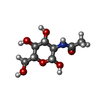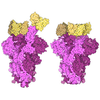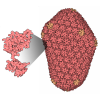+ Open data
Open data
- Basic information
Basic information
| Entry | Database: PDB / ID: 9bge | |||||||||
|---|---|---|---|---|---|---|---|---|---|---|
| Title | Cryo-EM structure of mAb8-24 bound to 426c.WITO.TM.SOSIP | |||||||||
 Components Components |
| |||||||||
 Keywords Keywords | IMMUNE SYSTEM / HIV / antibody | |||||||||
| Biological species |   Human immunodeficiency virus 1 Human immunodeficiency virus 1 | |||||||||
| Method | ELECTRON MICROSCOPY / single particle reconstruction / cryo EM / Resolution: 4.2 Å | |||||||||
 Authors Authors | Hurlburt, N.K. / Pancera, M. | |||||||||
| Funding support |  United States, 2items United States, 2items
| |||||||||
 Citation Citation |  Journal: J Virol / Year: 2024 Journal: J Virol / Year: 2024Title: Short CDRL1 in intermediate VRC01-like mAbs is not sufficient to overcome key glycan barriers on HIV-1 Env. Authors: Parul Agrawal / Maria L Knudsen / Anna MacCamy / Nicholas K Hurlburt / Arineh Khechaduri / Kelsey R Salladay / Gargi M Kher / Latha Kallur Siddaramaiah / Andrew B Stuart / Ilja Bontjer / ...Authors: Parul Agrawal / Maria L Knudsen / Anna MacCamy / Nicholas K Hurlburt / Arineh Khechaduri / Kelsey R Salladay / Gargi M Kher / Latha Kallur Siddaramaiah / Andrew B Stuart / Ilja Bontjer / Xiaoying Shen / David Montefiori / Harry B Gristick / Pamela J Bjorkman / Rogier W Sanders / Marie Pancera / Leonidas Stamatatos /   Abstract: VRC01-class broadly neutralizing antibodies (bnAbs) have been isolated from people with HIV-1, but they have not yet been elicited by vaccination. They are extensively somatically mutated and ...VRC01-class broadly neutralizing antibodies (bnAbs) have been isolated from people with HIV-1, but they have not yet been elicited by vaccination. They are extensively somatically mutated and sometimes accumulate CDRL1 deletions. Such indels may allow VRC01-class antibodies to accommodate the glycans expressed on a conserved N276 N-linked glycosylation site in loop D of the gp120 subunit. These glycans constitute a major obstacle in the development of VRC01-class antibodies, as unmutated antibody forms are unable to accommodate them. Although immunizations of knock-in mice expressing human VRC01-class B-cell receptors (BCRs) with specifically designed Env-derived immunogens lead to the accumulation of somatic mutations in VRC01-class BCRs, CDRL1 deletions are rarely observed, and the elicited antibodies display narrow neutralizing activities. The lack of broad neutralizing potential could be due to the absence of deletions, the lack of appropriate somatic mutations, or both. To address this point, we modified our previously determined prime-boost immunization with a germline-targeting immunogen nanoparticle (426c.Mod.Core), followed by a heterologous core nanoparticle (HxB2.WT.Core), by adding a final boost with a cocktail of various stabilized soluble Env trimers. We isolated VRC01-like antibodies with extensive somatic mutations and, in one case, a seven-amino acid CDRL1 deletion. We generated chimeric antibodies that combine the vaccine-elicited somatic mutations with CDRL1 deletions present in human mature VRC01 bnAbs. We observed that CDRL1 indels did not improve the neutralizing antibody activities. Our study indicates that CDRL1 length by itself is not sufficient for the broadly neutralizing phenotype of this class of antibodies. IMPORTANCE: HIV-1 broadly neutralizing antibodies will be a key component of an effective HIV-1 vaccine, as they prevent viral acquisition. Over the past decade, numerous broadly neutralizing ...IMPORTANCE: HIV-1 broadly neutralizing antibodies will be a key component of an effective HIV-1 vaccine, as they prevent viral acquisition. Over the past decade, numerous broadly neutralizing antibodies (bnAbs) have been isolated from people with HIV. Despite an in-depth knowledge of their structures, epitopes, ontogenies, and, in a few rare cases, their maturation pathways during infection, bnAbs have, so far, not been elicited by vaccination. This necessitates the identification of key obstacles that prevent their elicitation by immunization and overcoming them. Here we examined whether CDRL1 shortening is a prerequisite for the broadly neutralizing potential of VRC01-class bnAbs, which bind within the CD4 receptor binding site of Env. Our findings indicate that CDRL1 shortening by itself is important but not sufficient for the acquisition of neutralization breadth, and suggest that particular combinations of amino acid mutations, not elicited so far by vaccination, are most likely required for the development of such a feature. | |||||||||
| History |
|
- Structure visualization
Structure visualization
| Structure viewer | Molecule:  Molmil Molmil Jmol/JSmol Jmol/JSmol |
|---|
- Downloads & links
Downloads & links
- Download
Download
| PDBx/mmCIF format |  9bge.cif.gz 9bge.cif.gz | 996.5 KB | Display |  PDBx/mmCIF format PDBx/mmCIF format |
|---|---|---|---|---|
| PDB format |  pdb9bge.ent.gz pdb9bge.ent.gz | 714.7 KB | Display |  PDB format PDB format |
| PDBx/mmJSON format |  9bge.json.gz 9bge.json.gz | Tree view |  PDBx/mmJSON format PDBx/mmJSON format | |
| Others |  Other downloads Other downloads |
-Validation report
| Summary document |  9bge_validation.pdf.gz 9bge_validation.pdf.gz | 3.3 MB | Display |  wwPDB validaton report wwPDB validaton report |
|---|---|---|---|---|
| Full document |  9bge_full_validation.pdf.gz 9bge_full_validation.pdf.gz | 3.4 MB | Display | |
| Data in XML |  9bge_validation.xml.gz 9bge_validation.xml.gz | 78.8 KB | Display | |
| Data in CIF |  9bge_validation.cif.gz 9bge_validation.cif.gz | 119.8 KB | Display | |
| Arichive directory |  https://data.pdbj.org/pub/pdb/validation_reports/bg/9bge https://data.pdbj.org/pub/pdb/validation_reports/bg/9bge ftp://data.pdbj.org/pub/pdb/validation_reports/bg/9bge ftp://data.pdbj.org/pub/pdb/validation_reports/bg/9bge | HTTPS FTP |
-Related structure data
- Links
Links
- Assembly
Assembly
| Deposited unit | 
|
|---|---|
| 1 |
|
- Components
Components
-Protein , 1 types, 3 molecules BCA
| #1: Protein | Mass: 69535.422 Da / Num. of mol.: 3 Source method: isolated from a genetically manipulated source Source: (gene. exp.)   Human immunodeficiency virus 1 / Cell line (production host): HEK 293E / Production host: Human immunodeficiency virus 1 / Cell line (production host): HEK 293E / Production host:  Homo sapiens (human) Homo sapiens (human) |
|---|
-Antibody , 2 types, 6 molecules DFHEGL
| #2: Antibody | Mass: 25560.518 Da / Num. of mol.: 3 Source method: isolated from a genetically manipulated source Source: (gene. exp.)   Homo sapiens (human) Homo sapiens (human)#3: Antibody | Mass: 22049.486 Da / Num. of mol.: 3 Source method: isolated from a genetically manipulated source Source: (gene. exp.)   Homo sapiens (human) Homo sapiens (human) |
|---|
-Sugars , 5 types, 54 molecules 
| #4: Polysaccharide | 2-acetamido-2-deoxy-beta-D-glucopyranose-(1-4)-2-acetamido-2-deoxy-beta-D-glucopyranose Source method: isolated from a genetically manipulated source #5: Polysaccharide | alpha-D-mannopyranose-(1-3)-[alpha-D-mannopyranose-(1-6)]beta-D-mannopyranose-(1-4)-2-acetamido-2- ...alpha-D-mannopyranose-(1-3)-[alpha-D-mannopyranose-(1-6)]beta-D-mannopyranose-(1-4)-2-acetamido-2-deoxy-beta-D-glucopyranose-(1-4)-2-acetamido-2-deoxy-beta-D-glucopyranose Source method: isolated from a genetically manipulated source #6: Polysaccharide | alpha-D-mannopyranose-(1-2)-alpha-D-mannopyranose-(1-3)-beta-D-mannopyranose-(1-4)-2-acetamido-2- ...alpha-D-mannopyranose-(1-2)-alpha-D-mannopyranose-(1-3)-beta-D-mannopyranose-(1-4)-2-acetamido-2-deoxy-beta-D-glucopyranose-(1-4)-2-acetamido-2-deoxy-beta-D-glucopyranose Source method: isolated from a genetically manipulated source #7: Polysaccharide | Source method: isolated from a genetically manipulated source #8: Sugar | ChemComp-NAG / |
|---|
-Details
| Has ligand of interest | N |
|---|---|
| Has protein modification | Y |
-Experimental details
-Experiment
| Experiment | Method: ELECTRON MICROSCOPY |
|---|---|
| EM experiment | Aggregation state: PARTICLE / 3D reconstruction method: single particle reconstruction |
- Sample preparation
Sample preparation
| Component | Name: Complex of 426c.WITO.TM.SOSIP bound to three mAb 8-24 Fabs Type: COMPLEX / Entity ID: #1-#3 / Source: RECOMBINANT |
|---|---|
| Molecular weight | Value: 0.21 MDa / Experimental value: NO |
| Source (natural) | Organism:  Homo sapiens (human) Homo sapiens (human) |
| Source (recombinant) | Organism:  Homo sapiens (human) / Cell: HEK 293E Homo sapiens (human) / Cell: HEK 293E |
| Buffer solution | pH: 7.5 |
| Specimen | Conc.: 1.5 mg/ml / Embedding applied: NO / Shadowing applied: NO / Staining applied: NO / Vitrification applied: YES |
| Specimen support | Grid material: GOLD / Grid mesh size: 200 divisions/in. / Grid type: UltrAuFoil R2/2 |
| Vitrification | Instrument: FEI VITROBOT MARK IV / Cryogen name: ETHANE / Humidity: 100 % / Chamber temperature: 295.15 K |
- Electron microscopy imaging
Electron microscopy imaging
| Microscopy | Model: TFS GLACIOS |
|---|---|
| Electron gun | Electron source:  FIELD EMISSION GUN / Accelerating voltage: 200 kV / Illumination mode: FLOOD BEAM FIELD EMISSION GUN / Accelerating voltage: 200 kV / Illumination mode: FLOOD BEAM |
| Electron lens | Mode: BRIGHT FIELD / Nominal magnification: 36000 X / Nominal defocus max: 2500 nm / Nominal defocus min: 1000 nm / Cs: 2.7 mm / C2 aperture diameter: 50 µm |
| Image recording | Electron dose: 50 e/Å2 / Film or detector model: GATAN K3 (6k x 4k) |
- Processing
Processing
| EM software |
| ||||||||||||||||||||||||
|---|---|---|---|---|---|---|---|---|---|---|---|---|---|---|---|---|---|---|---|---|---|---|---|---|---|
| CTF correction | Type: PHASE FLIPPING AND AMPLITUDE CORRECTION | ||||||||||||||||||||||||
| Particle selection | Num. of particles selected: 2600000 | ||||||||||||||||||||||||
| Symmetry | Point symmetry: C3 (3 fold cyclic) | ||||||||||||||||||||||||
| 3D reconstruction | Resolution: 4.2 Å / Resolution method: FSC 0.143 CUT-OFF / Num. of particles: 23004 / Symmetry type: POINT | ||||||||||||||||||||||||
| Refinement | Cross valid method: NONE Stereochemistry target values: GeoStd + Monomer Library + CDL v1.2 | ||||||||||||||||||||||||
| Displacement parameters | Biso mean: 263.39 Å2 | ||||||||||||||||||||||||
| Refine LS restraints |
|
 Movie
Movie Controller
Controller





 PDBj
PDBj



